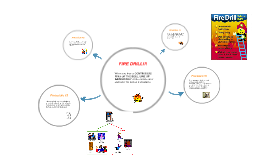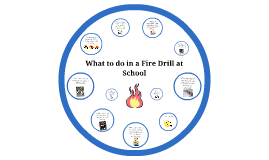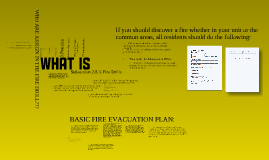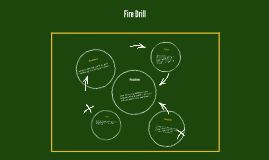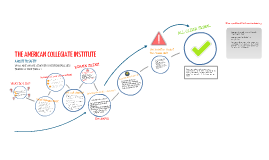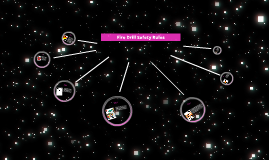FIRE DRILL
Transcript: WHAT IS •A fire drill is a method of practicing the evacuation of a building for a fire or other emergency. Generally, the emergency system (usually an alarm) is activated and the building is evacuated as though a real fire had occurred. Usually, the time it takes to evacuate is measured to ensure that it occurs within a reasonable length of time. Subsection 2.8.3. Fire Drills (1) Fire drills shall be held at least once during each 12-month period for the supervisory staff, except that: •In day care centres, facilities regulated by or under the Developmental Services Act and care or detention occupancies, fire drills shall be held at least monthly, • In schools attended by children, total evacuation fire drills shall be held three times in each of the fall and spring school terms, and •In buildings within the scope of Subsection 3.2.6. of Division B of the Building Code, fire drills shall be held every three months. (2) In addition to the requirements of Sentence (1), every employee in a hotel establishment shall take part in at least one fire drill during each 12-month period. (3) Records of a fire drill required by this Article shall be kept for 12 months after the fire drill. FIRE DRILL PROCEDURE • Upon hearing a fire alarm, leave the building immediately. • Walk, don’t run. ALWAYS USE STAIRWELLS; DO NOT USE ELEVATORS! • If there is a delay getting through the exit, do not shove. Wait your turn. Keep calm. • DO NOT DELAY leaving the building. Forget valuables, save your life! • Assist any handicapped person or visitor in the building. • NEVER ASSUME AN ALARM IS A TEST! 1. Smoke Alarms o Every level of a building or home needs a working smoke alarm. Though hard-wired smoke alarms are more reliable, even homes with battery-operated alarms save lives, according to the National Fire Protection Agency (NFPA). In 2010, the NFPA reports the death rate is twice as much for every 100 reported home fires without alarms than those with working smoke alarms. 2.Know the Escape Routes o Every room needs two escape outlets in case flames block the main exit, according to the USFA. When the next best escape exit includes crawling from a window onto a roof or out a lofty window, use only laboratory-evaluated collapsible ladders by nationally recognized companies. Training for safe fire evacuation requires a minimum two active reviews a year. 3.Practice o While practicing fire safety routes from every room, the exercise should include rehearsing in the dark or at least with closed eyes, using hands feeling the way out. Assuring windows open easily with rapid screen removal, preparation saves valuable time in escaping a fire. Particularly important is a run-through of the removal of security bars with quick-release latches. 4.Beware of Hot Doors o In an actual fire, feeling for heat at the top of the door, the doorknob and the gap between door and frame means switching to the secondary escape route. Doors cool to the touch need to be opened slowly with the shoulder ready to slam the door securely shut should smoke or heat begin entering, which also signals use of an alternate escape route. 5.Escaping in Smoke o The best method to limit smoke inhalation, causing disorientation or unconsciousness, is crawling low along the escape route while covering the mouth. Exit quickly and never waste valuable time grabbing property. 6.Taking Count o Once everyone escapes safely, a predetermined meeting place by a tree or other familiar landmark (not necessarily across the street) away from the burning building allows for an accounting of all family members. Never go back into a burning building. 7.Communicate o Call the fire department after escaping a burning home from a neighbor's house, using either 911 or the designated number particular to the area. Teach children that it's OK to talk to firefighters if they do not see other family members expedite rescue procedures. WHO ARE ASSIGN IN THE FIRE DRILL??? • BUILDING SERVICES STAFF • EVACUATION COORDINATORS • ASSISTANT EVACUATION COORDINATORS BASIC FIRE EVACUATION PLAN: • In event of a fire, go immediately to the nearest fire alarm pull station and sound the alarm by pulling down on the lever. These fire alarm pull stations are located at or around high traffic areas, usually near an exit. Please look at your building’s Emergency Evacuation floor plans for their specific locations. • The person discovering the fire then has someone advise the designated Evacuation Coordinator of the circumstances, if they do not already know, who proceeds with informing all occupants in their assigned area to vacate the premises (which they should have already started to do when they hear the alarm), in accordance with the routes outlined on the floor plans. (Your office plan will outline the primary route for leaving the building and should be used in all instances except when circumstances prevent it such as the location of the fire/emergency. In that event, an alternate route will be determined at






